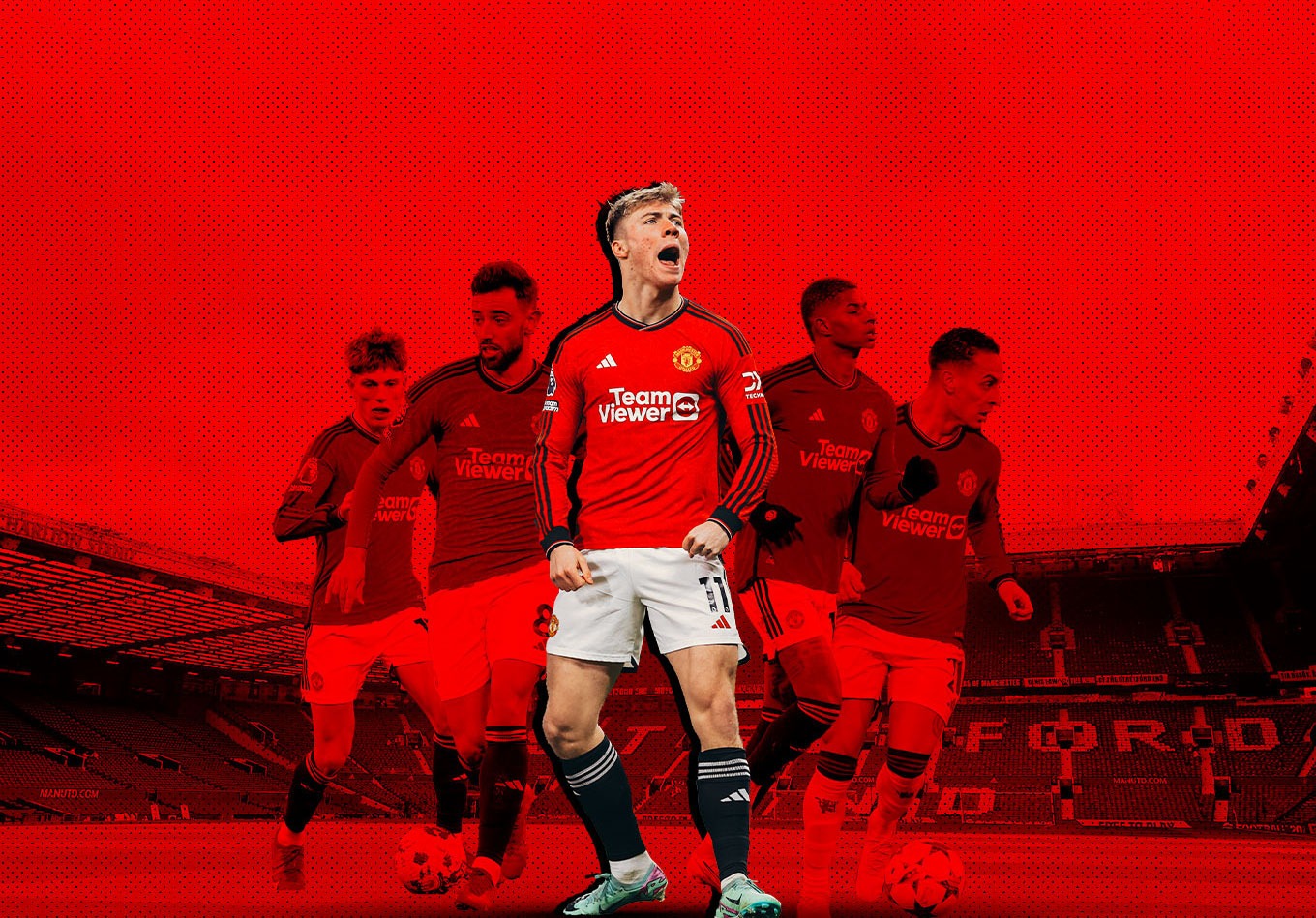Rasmus Højlund’s first few months at Manchester United have been difficult, but his teammates have to shoulder some of the blame.
It was ‘only’ a goal against League Two opposition, but Rasmus Højlund’s strike in the 4-2 FA Cup win over Newport County spoke volumes about a frustrating first few months at Manchester United for the Danish striker.
His celebration, if you can call it that, was more like a release of pent-up fury and annoyance. There was barely a hint of a smile, rather a reaction that some might perceive as a not-so-subtle message to his teammates.
That wouldn’t be a baseless suggestion. His displeasure was plain to see on multiple occasions during Sunday’s largely unimpressive victory. In the first half, Alejandro Garnacho was released into the left side of the box but decided to go for goal from a difficult angle instead of passing into the six-yard box where Højlund was waiting for a tap-in; the Argentina international hit the crossbar but it’s fair to say he made the wrong decision, and Højlund’s reaction, although not directed at his teammate, left little room for misinterpretation.
Then, late in the second half, Garnacho again had possession in the left side of the box, but rather than flash a low ball into the danger zone towards Antony and Højlund, he feinted back inside and was instantly dispossessed. This time he received both barrels from Højlund, who gave the winger a real rollicking.
So, when Højlund finally got his goal about 13 minutes later in second-half stoppage time, the emotion in his reaction made perfect sense.
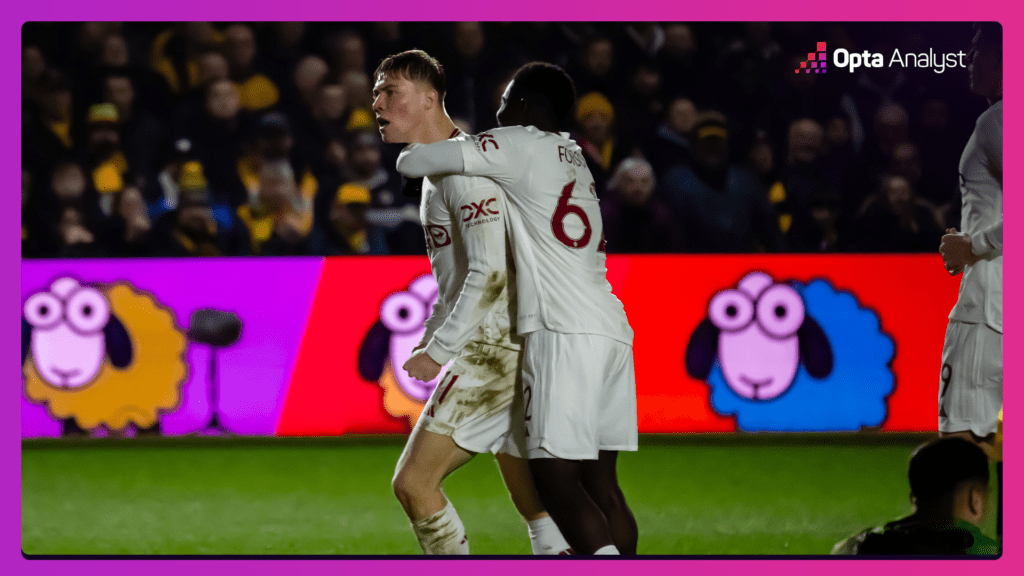
After all, in some ways that game represented a microcosm of his United career. He worked hard up top and brought others into play well, but a lack of service had him feeding off scraps; even his goal fell into that category, he just happened to be well positioned to pounce when Omari Forson’s effort on the stretch was blocked by the goalkeeper.
That strike was Højlund’s only shot of a game in which United had 22, and it took nearly 94 minutes for it to arrive. Antony had six; Bruno Fernandes and Garnacho managed five each; even five Newport players registered at least two attempts, Will Evans and Bryn Morris tallying nine between them.
It wouldn’t be right to say Højlund has been faultless this season; he obviously hasn’t. The long wait for his first Premier League goal was excruciating to watch and saw him become synonymous with supposed “lookalike” Sean Millis, the Australian singer whose song ‘Waiting on a Miracle’ went to No. 1 on the UK Viral singles chart largely down to its social media association with Højlund’s woes. However, Sunday’s game was just the latest piece of evidence pointing to his underwhelming productivity in front of goal being at least partly down to those around him.
Critics will, of course, urge him to look at his own game, what he might be doing wrong, what he could potentially do better, et cetera. And that is fair, but he – like any good striker – still needs help. At a club like United, the first-choice centre-forward shouldn’t be starved for service.
Only two United players have created more than one chance in open play for Højlund in the Premier League this season; Marcus Rashford and Fernandes have each laid on four opportunities to him, though that’s hardly impressive. In fact, there are 93 instances in the Premier League this term of a player creating more chances for an individual teammate, with the most being Mohamed Salah’s 19 for Darwin Núñez.
Other United combinations account for five of those 93, with Fernandes to Antony and Fernandes to Garnacho (seven each) their most fruitful in the league, which arguably helps illustrate part of the issue at hand.
United are so reliant on the creative talents of Fernandes but his record suggests he looks to the wide players more often. Perhaps that’s out of habit considering they didn’t have a reliable centre-forward at all really last season, when United’s most frequent combinations for shots were Fernandes to Rashford (24, the most in the Premier League) and Fernandes to Antony (17, joint-fifth in the Premier League). So clearly, he and Højlund improving their on-pitch understanding would be a boost.
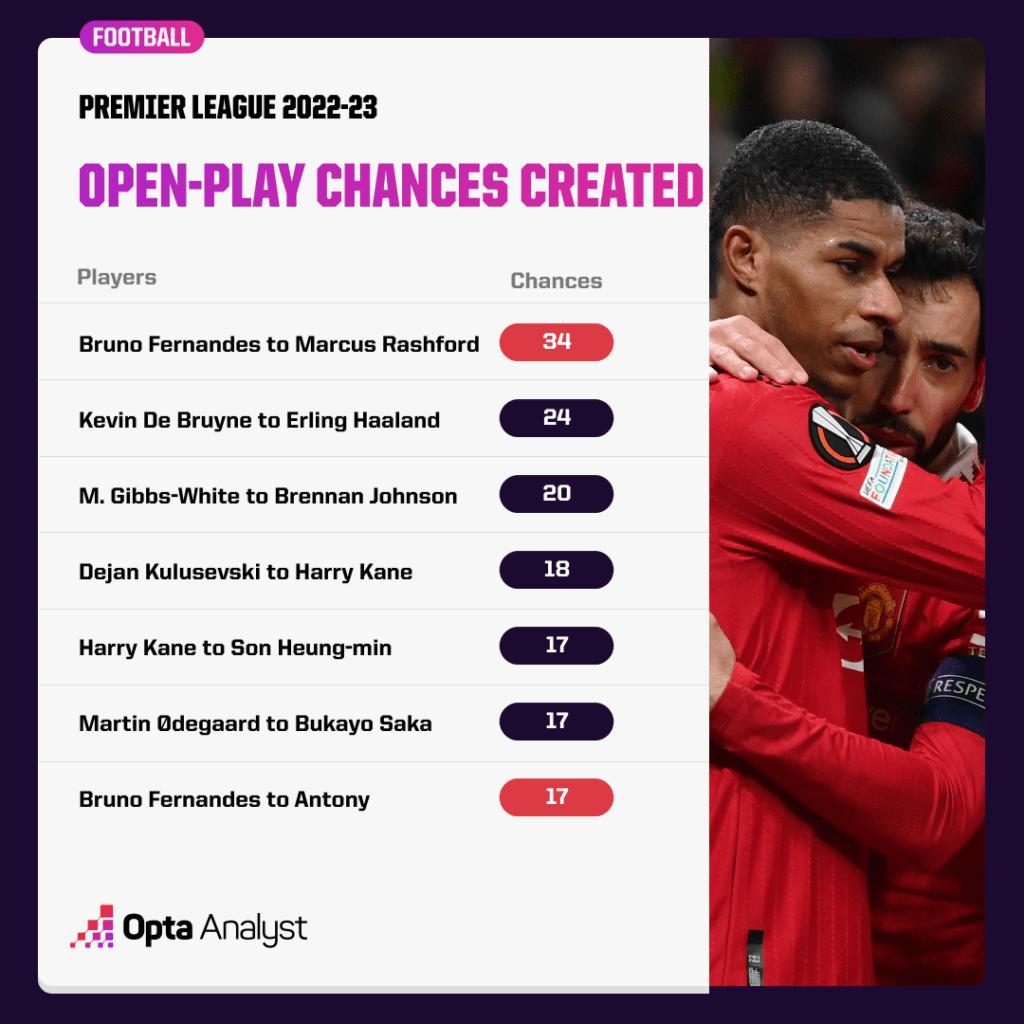
But, as good as Fernandes is, this is where their reliance on him becomes problematic; it’s not just on him to take that responsibility, others need to be creative outlets as well.
We can get a better idea of the standard of creativity that Højlund is being served by looking at expected goals (xG) assisted; this looks at the xG total of shots taken following chance-creating passes, thus allowing us to quantify a player’s (or players’) ability to find teammates in dangerous positions.
The cumulative xG assisted value of all open-play chance-creating passes to Højlund in the Premier League this season is just 1.30, which, ahead of Matchday 22, is only enough to see him rank joint-93rd in the whole league; even Aston Villa right-back Matt Cash (1.9) is among those higher up.
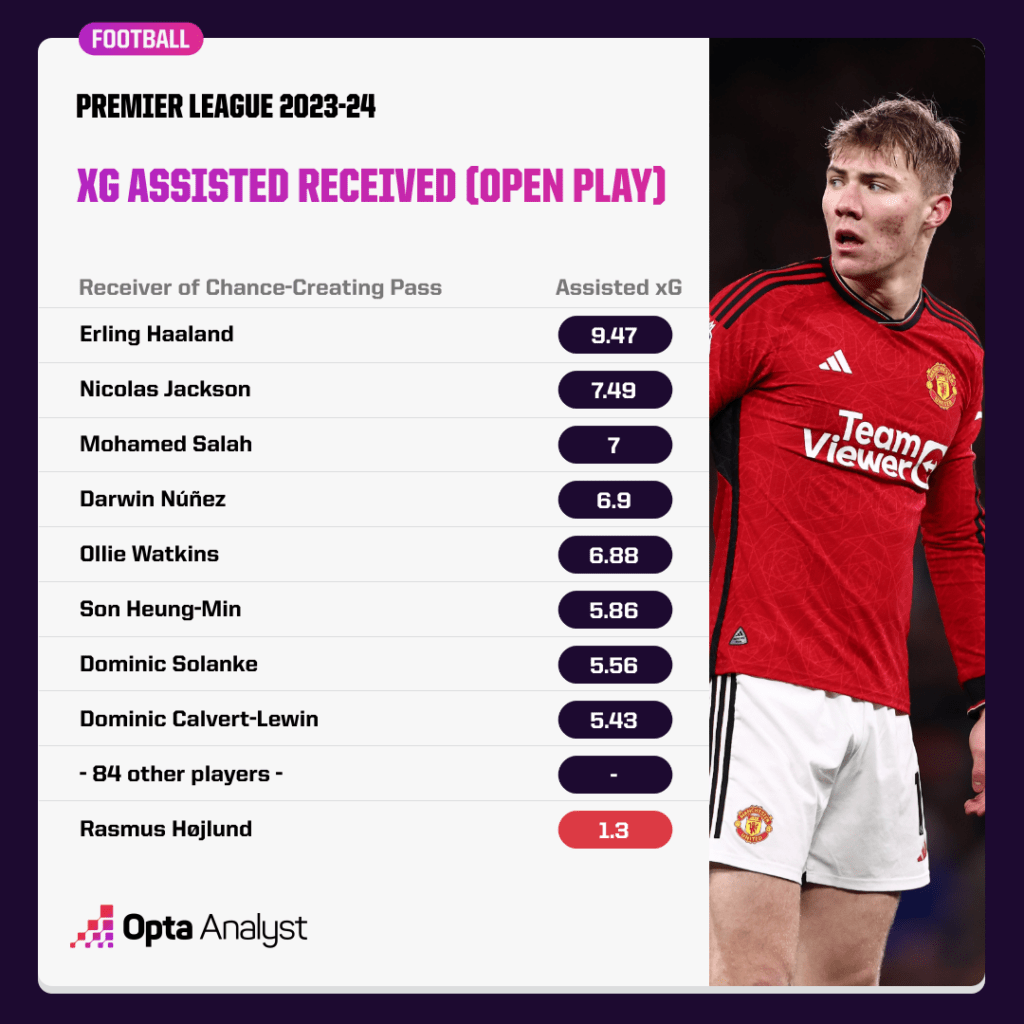
That comes from just 12 chance-creating passes to Højlund from teammates; 26 other strikers have been set up more often than him. In fact, of the 42 strikers to have received at least five chance-creating passes in the top flight, Højlund is one of just four yet to be assisted by a teammate (along with Rodrigo Muniz, Armando Broja and William Osula).
However, it was a different story in the UEFA Champions League. Five of Højlund’s eight United goals have come in Europe, and the data points to him being used more often. For instance, the 2.1 xG assisted value of open-play chance-creating passes to him was the fifth highest in the group stage. We have to take into consideration that this was boosted by his tap-in from Scott McTominay’s pass against FC Copenhagen being worth 0.92 xG, but we should also highlight that he was set up for eight open-play opportunities in six matches by teammates in the UCL (1.33 per game) compared to 12 in 16 Premier League games (0.75 per game).
One theory as to why Højlund seemed to have greater luck in the Champions League is that United sat back more, placing greater emphasis on being a threat in transition. After all, their PPDA (the average number of passes the opponents are allowed before United engage with a defensive action) was higher in the Champions League (15.2) than domestically (12.5), evidence of less emphasis on a high press in Europe, and they recorded nine fast breaks in the UCL (1.5 per game) compared to 14 in the Premier League (0.66 per game).
It’s no mystery why this might suit the deceptively quick Højlund. His second goal in Copenhagen came via a tap-in after Garnacho tore away and had a shot parried; the Dane’s header at home to Galatasaray was at the end of a rapid breakaway with Rashford; and his second in that game arrived after he ran almost half the length of the pitch with the ball, showcasing his athleticism and then subtlety with a smart finish.
Nevertheless, United finished bottom of their Champions League group and so won’t be playing European football at all for the rest of the season. It also seems unlikely Erik ten Hag will be making any major tactical alterations between now and the end of the campaign, so it’ll fall on Højlund to take a degree of responsibility for his own output and on-pitch rapport with teammates.
So, what more can he do?
Some might argue he could drop deep less and spend more time concentrating on his positioning in the area. He’s a hard worker and does a lot of pressing, but the graphic below shows how a significant portion of his pressures occur a long distance from goal.
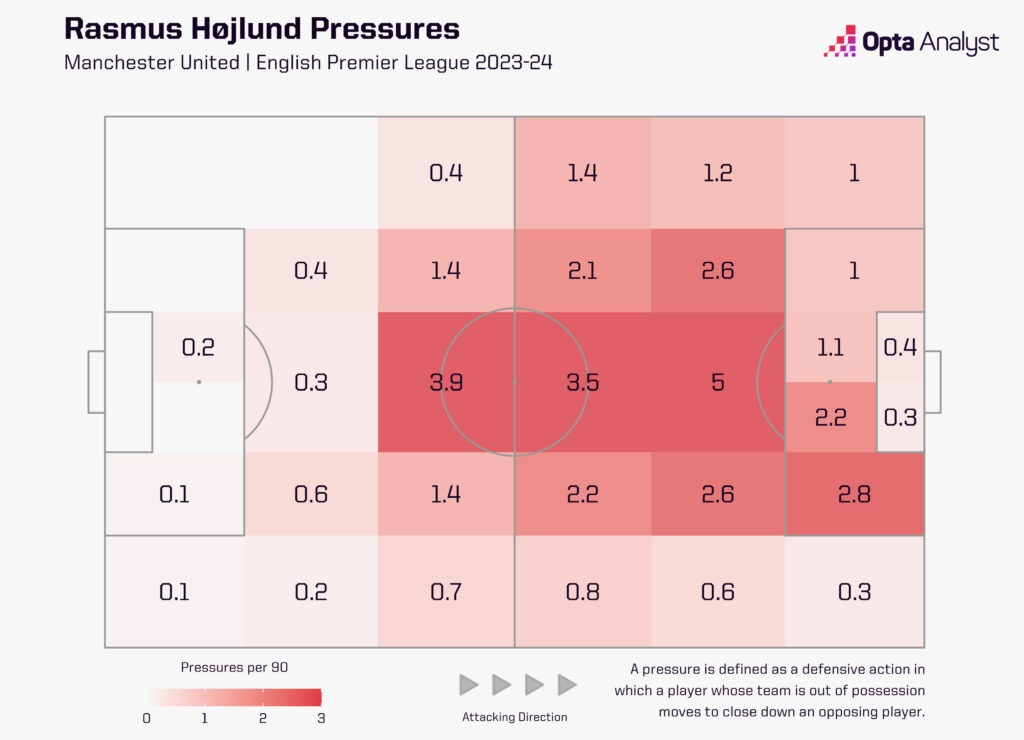
Considering he averages 16.1 touches per shot, far more than the likes of Erling Haaland (5.5), Callum Wilson (8.4) and Núñez (8.6), focusing those pressures higher up the pitch might be beneficial in terms of his proximity to the area – Bournemouth’s Dominic Solanke recently suggested a tweak like this helped improve his output considerably.
In the interest of balance, Højlund is actually making more off-ball runs into the box per 90 minutes (11.1) than all but three strikers (minimum 500 minutes played) in the Premier League this season, significantly more even than Haaland (8.7), so it can’t be said he offers no presence in the area. The problem is, only 35.3% of those are targeted runs (movements that are followed immediately by a teammate attempting a pass), meaning he ranks behind 17 players in that metric; for context, 44.8% (ranked second) of Haaland’s runs into the box are targeted by a teammate. Sacrificing a few touches elsewhere on the pitch might at least improve the odds of United’s other forwards finding Højlund, particularly considering how poor the xG assisted data suggests they’ve been in that respect this term.
Still, the emotion and attitude he showed at the weekend could also be a good indicator that he’s starting to take matters into his own hands more, ready to shout up when his needs – and the greater good of the team – aren’t being met.
United will hope Højlund’s passion boiling over is a sign of an inner fire that’s starting to emerge; that’s something they can channel, but he can’t do it all on his own.
All data in this article is accurate ahead of Matchday 22 of the 2023-24 Premier League season.
Enjoy this? Subscribe to our football newsletter to receive exclusive weekly content. You should also follow our social accounts over on X, Instagram, TikTok and Facebook.
